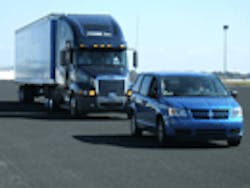Rear-end crashes are one of the most common claims for most fleet operations, whether comprised of light, medium, or heavy-duty vehicles, yet the cure for this issue remains relatively simple: increase the following distances between vehicles on the highway.
Recent analysis of seven million crashes compiled by San Diego-based DriveCam Inc. showed that vehicles maintaining less than two seconds worth of following distance are at a significantly higher risk of rear-end collisions.
Although recommended following distances can vary by weight and size of vehicle, most nationally recognized driver training programs advocate a minimum following distance of three or four seconds, explained Del Lisk, DriveCam’s vp-safety services. The company’s Risk InfoCenter then categorized rear-end incidents it reviewed from its database into two groups – those in which a subject vehicle’s following distance was less than two seconds and those in which following distance was two seconds or more.
“There is no greater risk of being struck from the rear when the subject vehicle is maintaining less than two seconds than having greater than two seconds following distance,” Lisk said. “Incidents involving the subject rear ending the lead vehicle where the subject vehicle had less than two seconds of following distance was almost three times as common as those where the driver was maintaining a distance of two seconds or greater.”
Rear-end crashes are the second most common claim for most fleet operators, regardless of industry, according to Risk Management News, Volume 1, making up 17% of all claims and costing over $13,000 per claim. According to the Federal Motor Carrier Safety Administration’s (FMCSA) “Rear-end Large Truck Crashes” study, both truck-striking and truck-struck collisions account for 18% of all large trucks annually involved in vehicle accidents – some 70,000 out of 379,000 yearly crashes.
DriveCam’s study also showed that a large number of rear-end crashes involve a change in speed by the lead vehicle or an interruption to the flow of traffic in the lane. In fact, more rear-end crashes happen in the farthest right lane than other lanes when on city streets, said Lisk.
He noted that the right lane has pedestrians, parked cars and turning vehicles that are constantly disturbing traffic flow, while the left-most lane was the next most frequent lane for accidents since it can be impacted by traffic slowing or stopping to make a left turn. The center lane, however, had far fewer incidents of rear-end crashes.
“This is partially due to the fact that more of the roads had only one or two lanes of same direction traffic,” explained Lisk. “However, it may also be due to the fact that the center lane has fewer traffic flow disturbances.”
About the Author
Sean Kilcarr
Editor in Chief
Sean Kilcarr is a former longtime FleetOwner senior editor who wrote for the publication from 2000 to 2018. He served as editor-in-chief from 2017 to 2018.
